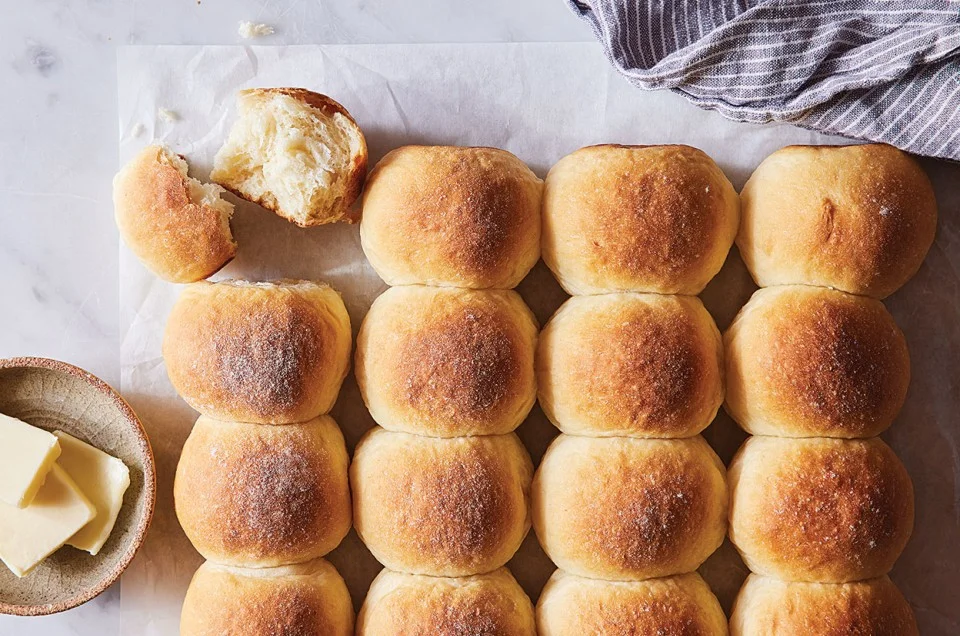There’s something magical about pulling a tray of warm, golden dinner rolls from the oven—their soft, pillowy texture and buttery aroma can make any meal feel like a special occasion. I still remember my first attempt at baking rolls for a family gathering; they were more like hockey pucks than bread, but years of practice (and a few kitchen disasters) taught me the secrets to perfect rolls. This comprehensive guide will walk you through every step to create soft dinner rolls that steal the show, whether you’re hosting a holiday feast or just craving comfort food. Packed with tips, variations, and a touch of humor, this article is your ticket to baking bliss.
What Are Soft Dinner Rolls?
Soft dinner rolls are small, round breads with a tender crumb and a slightly crisp, golden crust, perfect for soaking up gravy or spreading with butter. They’re a staple at dinners, from casual weeknight meals to festive holiday tables. Think of them as the ultimate sidekick to any main course—versatile, comforting, and universally loved.
A Brief History of Dinner Rolls
Dinner rolls have roots in European bread-making traditions, evolving in America as a must-have for hearty meals. By the 19th century, they were a symbol of hospitality, often served warm to guests. Their enduring popularity lies in their simplicity and ability to complement any dish.
Why Soft Dinner Rolls Are a Must-Have
These rolls are beloved for their fluffy texture and ability to pair with everything from soups to roasts. They’re easy to make in batches, freeze well, and elevate any meal with minimal effort. Plus, who can resist tearing into a warm roll fresh from the oven?
The Science of Fluffy Dinner Rolls
Great dinner rolls are a balance of technique and ingredients—too much kneading, and they’re tough; too little, and they won’t hold shape. The secret lies in activating yeast, using enriched dough, and mastering the knead. Let’s dive into the science to ensure your rolls are light as a cloud.
The Role of Yeast
Yeast is the powerhouse behind fluffy rolls, fermenting sugars to produce carbon dioxide that makes dough rise. Use active dry or instant yeast, and ensure your water is warm (about 110°F) to wake it up without killing it. A pinch of sugar speeds up the process.
Why Enriched Dough Makes a Difference
Soft dinner rolls rely on enriched dough, which includes milk, butter, and eggs for tenderness and richness. These ingredients slow gluten development, keeping the rolls soft rather than chewy. Think of it as giving your dough a cozy, buttery hug.
Flour Choices for Perfect Rolls
Bread flour, with its higher protein content (12–14%), is ideal for structure and chew, but all-purpose flour works for softer rolls. Avoid over-flouring the dough to maintain that tender crumb. Measuring by weight ensures precision—260g of flour is your sweet spot.
Classic Soft Dinner Rolls Recipe: Step-by-Step
Ready to bake? This foolproof recipe makes 12 fluffy rolls that are golden on the outside and irresistibly soft inside. Follow these steps, and you’ll have dinner rolls that rival any bakery’s. Let’s get rolling!
Ingredients for Soft Dinner Rolls
Here’s what you’ll need for perfect rolls:
- 3 cups (360g) bread flour or all-purpose flour
- 1/4 cup (50g) granulated sugar
- 2 1/4 teaspoons (1 packet) active dry yeast
- 1 teaspoon salt
- 3/4 cup (180ml) whole milk, warmed to 110°F
- 1/4 cup (60g) unsalted butter, melted and cooled
- 1 large egg, room temperature
- 2 tablespoons butter, melted (for brushing)
These pantry staples come together to create rolls that are both rich and airy.
Step-by-Step Instructions
- Activate the Yeast: In a small bowl, combine warm milk, sugar, and yeast. Let sit for 5–10 minutes until foamy.
- Mix the Dough: In a large bowl, whisk flour and salt. Add yeast mixture, melted butter, and egg. Stir until a shaggy dough forms.
- Knead: Turn dough onto a lightly floured surface and knead for 8–10 minutes until smooth and elastic.
- First Rise: Place dough in a greased bowl, cover, and let rise in a warm place for 1–1.5 hours until doubled.
- Shape Rolls: Punch down dough, divide into 12 equal pieces, and shape into balls. Place in a greased 9×13-inch pan.
- Second Rise: Cover and let rise for 30–45 minutes until puffy.
- Bake: Preheat oven to 375°F (190°C). Bake for 15–18 minutes until golden. Brush with melted butter.
- Serve: Cool slightly and serve warm with butter or your favorite spread.
This recipe is straightforward but precise, ensuring rolls that are soft and flavorful every time.
Essential Tools for Baking Rolls
To make rolls like a pro, gather these tools:
- Stand mixer with dough hook: For effortless kneading (optional but helpful).
- Digital scale: For precise flour measurements.
- 9×13-inch baking pan: For evenly shaped rolls.
- Pastry brush: For that glossy butter finish.
Find these at kitchen stores or online at Target or Williams Sonoma.
Variations to Elevate Your Rolls
Once you’ve nailed the classic recipe, experiment with flavors to keep things exciting. From sweet to savory, these variations will make your rolls the talk of the table. My family begs for the garlic herb version every Sunday!
Sweet Roll Variations
Sweet rolls are perfect for brunch or dessert. Try these:
- Cinnamon Sugar: Brush with butter and sprinkle with a cinnamon-sugar mix before baking.
- Honey Butter: Add 2 tablespoons honey to the dough for a subtle sweetness.
- Orange Zest: Mix in 1 tablespoon orange zest for a citrusy twist.
These sweet rolls pair beautifully with a morning coffee or tea.
Savory Roll Variations
Savory rolls are ideal for dinner or as a snack. Consider these:
- Garlic Herb: Add 1 teaspoon garlic powder and 2 tablespoons chopped fresh herbs (e.g., rosemary, thyme) to the dough.
- Cheddar Jalapeño: Fold in 1 cup shredded cheddar and 1 diced jalapeño for a spicy kick.
- Parmesan Black Pepper: Mix in 1/2 cup grated Parmesan and 1 teaspoon cracked black pepper.
These savory options are perfect with soups or roasts.
Dietary-Friendly Options
Everyone should enjoy fresh rolls! Try these adaptations:
- Gluten-Free: Use a 1:1 gluten-free bread flour blend, like King Arthur’s.
- Vegan: Swap milk for almond milk, butter for vegan margarine, and egg for a flax egg (1 tbsp flaxseed + 3 tbsp water).
These tweaks ensure inclusivity without compromising taste.
Comparison: Dinner Rolls vs. Other Breads
Dinner rolls are often confused with other breads, but they stand out for their softness. Here’s how they compare to similar baked goods.
| Feature | Dinner Rolls | Biscuits | Brioche |
|---|---|---|---|
| Texture | Soft, fluffy | Flaky, tender | Rich, cake-like |
| Ingredients | Milk, butter, egg | Butter, buttermilk | High butter, egg content |
| Sweetness | Slightly sweet | Savory | Sweet, decadent |
| Uses | Side for meals | Breakfast, gravy | Buns, desserts |
Dinner rolls are the versatile middle ground, perfect for any meal.
Pros and Cons of Making Dinner Rolls at Home
Baking rolls is rewarding, but it’s not without challenges. Here’s a balanced look at the pros and cons.
Pros
- Customizable: Add herbs, cheese, or sweets to suit your taste.
- Cost-Effective: Homemade rolls are cheaper than bakery-bought.
- Freezer-Friendly: Make a big batch and freeze for later.
Homemade rolls let you control quality and impress guests with minimal cost.
Cons
- Time-Intensive: Rising times mean you need to plan ahead.
- Learning Curve: Kneading and shaping take practice to perfect.
- Yeast Sensitivity: Incorrect temperatures can kill yeast, leading to flat rolls.
With patience, these hurdles are easy to overcome, and the results are worth it.
Tips for Perfect Dinner Rolls
Want rolls that rival a bakery’s? These tips, learned from my own trial and error (like the time I forgot the salt—yikes!), will ensure success. Follow these, and your rolls will be the star of the table.
Use Warm, Not Hot, Liquids
Yeast thrives at 100–110°F. Too hot, and it dies; too cold, and it won’t activate. Test with a thermometer or dip your finger—it should feel like a warm bath.
Knead Until Smooth
Knead for 8–10 minutes until the dough is elastic and passes the “windowpane test” (stretch a piece thin enough to see light through). This ensures a strong, airy structure.
Don’t Skip the Second Rise
The second rise gives rolls their fluffiness. Let them puff up in the pan until they touch each other for that classic pull-apart texture.
Brush with Butter Post-Bake
Brushing warm rolls with melted butter adds flavor and keeps the crust soft. For extra flair, sprinkle with flaky sea salt or herbs.
Where to Source Quality Ingredients
Great rolls start with great ingredients. Here’s where to find the best:
- Flour and Yeast: Stock up at Costco or Walmart for brands like Red Star Yeast.
- Butter and Milk: Opt for high-quality dairy from local markets or Whole Foods.
- Specialty Add-Ins: Find herbs, cheeses, or gluten-free flours at Thrive Market.
Investing in quality ingredients pays off in flavor and texture.
People Also Ask (PAA) Section
Here are answers to common Google questions about dinner rolls, pulled from SERPs.
What Makes Dinner Rolls Soft?
Soft rolls get their texture from enriched dough (milk, butter, eggs) and proper kneading. Avoid overbaking, and brush with butter after baking to lock in moisture.
Can You Make Dinner Rolls Without Yeast?
Yes, but they won’t be as fluffy. Use baking powder for a


